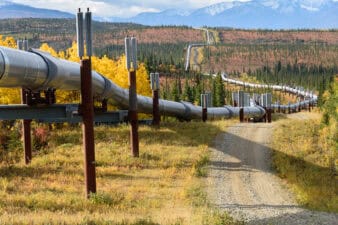Oil’s latest rally, which saw the North American benchmark West Texas Intermediate (WTI) surge to a multi-year high of over US$76 a barrel and the international price Brent reach over US$86, caused the spread between the two benchmarks to widen significantly to over US$10 per barrel. While crude has pulled back sharply in recent days, the price differential is still hovering at around US$9.50 a barrel. It is likely that it could widen further over coming months.
Such a wide price differential bodes well for upstream oil producers such as Gran Tierra Energy (TSX:GTE)NYSE:GTE), which operates in the Latin American nation of Colombia.
Now what?
Commodity analysts at Citigroup believe that the spread between WTI and Brent could expand to a five-year high of around U.S.$15 a barrel, as emerging supply constraints impact global oil supplies and U.S. inventories continue to grow. Roughly two-thirds of oil traded worldwide is referenced to Brent, and a series of emerging supply constraints, principally in the Middle East, are causing global ex-North American oil inventories to fall, pushing Brent higher.
A key reason for the wide differential between Brent and WTI is growing U.S. oil production combined with significant emerging global ex-North America supply constraints. These have the potential to significantly curtail international oil supplies, notably from OPEC, which is responsible for 43% of all oil produced globally.
The primary driver of the anticipated decline in OPEC’s oil output are the soon-to-be-reinstated sanctions in Iran, which are anticipated to remove 700,000 to one million barrels daily from world supplies. There is also the ongoing deterioration in Venezuela’s oil output, as its oil industry moves closer to total collapse as well as the likelihood of further supply outages in war-torn Libya.
This means that while North American oil supplies are growing, international supplies are falling creating a situation where the two benchmark prices will continue to diverge.
In fact, the wider the spread, the greater incentive there is for U.S. oil producers, notably in the shale oil patch, to boost production. If WTI is cheaper in comparison to Brent, the demand for U.S. oil exports will grow, creating a greater incentive for U.S. oil producers to ramp up production.
Another factor weighing on WTI relative to Brent is that the surge in U.S. shale oil production has flooded North American energy markets with crude, yet the majority of U.S. refineries are configured to process heavy oil. This has caused North American light oil inventories to surge, keeping pressure on WTI, while international inventories fall because of diminishing output and rising demand.
According to Citigroup commodity analysts, this confluence of events has the potential to push the price differential to as high as US$15 a barrel, which would be beneficial for those drillers able to access Brent pricing.
So what?
A particularly attractive intermediate upstream oil producer accessing Brent pricing is Gran Tierra. Through a series of acquisitions and organic growth initiatives, Gran Tierra has amassed an impressive portfolio of oil assets in Colombia in the country’s three main oil basins, the Llanos in the central east, Middle Magdalena Valley to the north, and Putumayo in the south.
Gran Tierra’s oil properties give it oil reserves of 137 million barrels, which have a net asset value (NAV) before tax of US$2.5 billion, or US$5.85 per share, which is 68% higher than its current market price. This emphasizes the considerable upside available, especially when it is considered that NAV was calculated using a forecast average Brent price of US$63.50 for 2018 and US$61.30 in 2019. Those prices are well below the current spot price of US$80 a barrel and Brent’s average of US$72.41 per barrel since the start of 2018, indicating that value of Gran Tierra’s reserves will expand.
The financial advantage provided by being able to access premium Brent pricing becomes apparent when examining Gran Tierra’s second-quarter 2018 netback compared to its Canadian peers operating solely in North America. For that period, the driller reported an operating netback of US$47.99 per barrel produced, which was an impressive 85% higher than the equivalent period in 2017. This was also 96% greater than Canadian light oil producer Whitecap Resources, which can only access WTI pricing and reported a second-quarter operating netback of US$24.45, highlighting Gran Tierra’s financial advantage.
The quality of Gran Tierra’s oil assets, its attractive valuation compared to the NAV of its oil reserves, growing production, rock-solid balance sheet, and the ability to access Brent pricing make it an extremely appealing play on higher crude.





